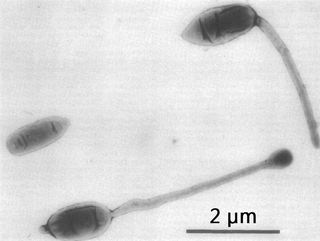The Thermomicrobia is a group of thermophilic green non-sulfur bacteria. Based on species Thermomicrobium roseum and Sphaerobacter thermophilus, this bacteria class has the following description:

The Hyphomicrobiaceae are a family of bacteria. Among others, they include Rhodomicrobium, a genus of purple bacteria.

The Burkholderiaceae are a family of bacteria included in the order Burkholderiales. It includes some pathogenic species, such as Burkholderia mallei (glanders) and Burkholderia pseudomallei (melioidosis). This family was found to be enriched in scale-eating pupfish guts, even after being fed a common laboratory diet, suggesting it may aid in scale-digestion.

Halomonadaceae is a family of halophilic Pseudomonadota.
The Gemmatimonadota are a phylum of bacteria established in 2003. The phylum contains two classes Gemmatimonadetes and Longimicrobia.
The Chloroflexota are a phylum of bacteria containing isolates with a diversity of phenotypes, including members that are aerobic thermophiles, which use oxygen and grow well in high temperatures; anoxygenic phototrophs, which use light for photosynthesis ; and anaerobic halorespirers, which uses halogenated organics as electron acceptors.
Desulfovirgula is a genus of sulfate reducing, anaerobic, endospore-forming, Gram-positive, thermophilic, motile, rod-shaped bacteria, isolated from an underground mining site in an area of Japan characterized by high geothermal activity.
Rhodopseudomonas is a genus of bacteria from the family Nitrobacteraceae.
Acetitomaculum is a genus in the phylum Bacillota (Bacteria). The single species is an acetogenic bacteria from the bovine rumen.
Yokenella is a genus of bacteria of the family Enterobacteriaceae. Yokenella are Gram-negative, motile, rod-shaped bacteria. Strains of bacteria forming this genus were originally isolated from clinical samples and from insects. There is only one species in this genus: Yokenella regensburgei.
Thermanaeromonas is a genus of bacteria within the family Thermoanaerobacteraceae. The type species of this genus is Thermanaeromonas toyohensis, a highly thermophilic anaerobe.
Muricauda taeanensis is a Gram-negative, strictly aerobic, heterotrophic and moderate halophilic bacterium from the genus of Muricauda which has been isolated from tidal flat sediments of Taean in Korea.
Bellilinea is a thermophilic bacteria genus from the family of Anaerolineaceae with one known species. Bellilinea caldifistulae has been isolated from thermophilic digester sludge from Niigata in Japan.
Saccharicrinis is genus of bacteria from the family of Marinilabiliaceae.
Terrabacter is a genus of Gram positive, strictly aerobic, non-sporeforming bacteria. The genus name is derived from Latin terra (earth), referring to the type species' original isolation from soil. The genus was first proposed in 1989; however, the type species Terrabacter tumescens was originally described in 1934, and had previously been classified in the genera Corynebacterium, Arthrobacter, and Pimelobacter. Terrabacter species have been isolated from soil, air and stone.
Fodinibacter is a genus of Gram positive, nonmotile, non-sporeforming bacteria. The bacteria are strictly aerobic and mesophilic. Cells of the genus are irregular rods and grow very poorly in the absence of NaCl. The genus name is derived from the Latin fodina (mine), referring to the salt mine from which the type of species was isolated.
Aquirufa is a genus of red-pigmented freshwater bacteria affiliated with the family of Cytophagaceae.
Emcibacteraceae is a family of bacteria.
Iodidimonas is a genus of bacteria that oxidizes iodide to iodine. It was isolated from iodide-rich brine associated with natural gas in Kujukuri, Japan.
Euzebya is a genus of Gram-positive bacteria.


